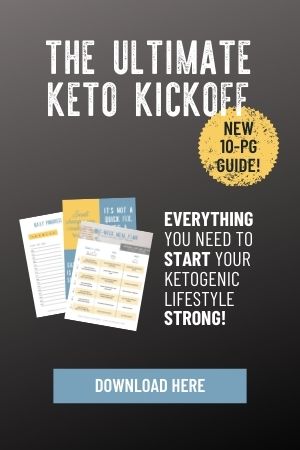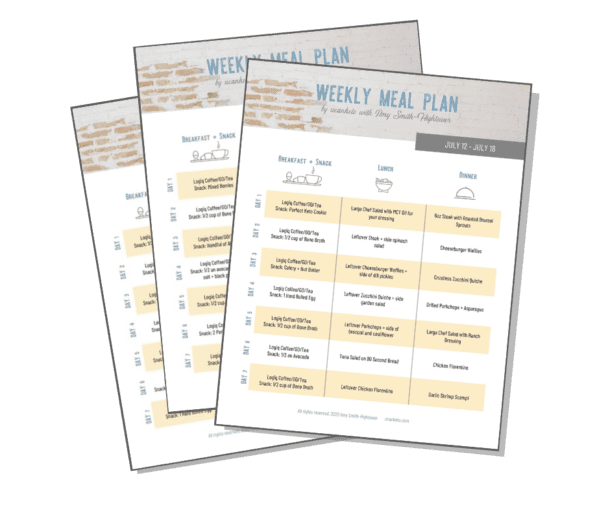So, you’ve decided to start the keto diet (congratulations, and we are here to help you be successful on this journey to weight loss and improved health). But, you want to do it “properly” – i.e. making sure you get everything your body needs, and minimizing any potential side effects. And so this post will cover the most common mistakes people make.
Top 5 keto diet mistakes (and our tips on how to avoid them):
1. Not getting enough fats in your diet
For our entire lives, we were told to limit the amount of fat we consumed, so making a mental switch to consuming MORE fat, can take some getting used to. I recommend a ratio of 70% fat, 25% protein, and 5% carbohydrate on the ketogenic diet.
However, many people first starting the keto diet consume too much protein – it is easy to do, it makes sense to our brain and supports the way much of society eats, and the thought of adding fat to beverages like coffee, just seems weird – at the beginning. Typically, I find that people need to cut the amount of protein they are eating by as much as 50% to achieve the right macro balance.
I will be sharing many surprising (and yummy) ways to increase your fat intake, and, all of the meal plans and recipes found (please add where they can find this stuff – I know on the FB page, but also get an email too?) are designed to support the 70-25-5 ratio.
2. Not measuring your levels properly
The state of ketosis is not difficult to maintain, however, it does take regular monitoring to ensure that you are staying in it. Many people assume that once they have achieved ketosis (and as long as they continue to follow the diet) that they will automatically stay there. This is not true, and many things can bump you out of ketosis without knowing.
A few of these are:
- Too much protein
- Unknowingly eating food containing hidden sugar
- Too much physical activity
- For some, artificial sweeteners
There are 3 main ways to measure your levels:
1. Testing your urine for ketone bodies (this is an easy, affordable, and effective method of testing for people who are newly on the keto diet -although once your body has adapted, the readings can be very inaccurate).
2. Measure your breath for acetone or acetate (types of ketone bodies that are produced when in ketosis) using a breath monitor.
3. Testing your blood using a device similar to those that diabetics use (finger prick) to determine your Glucose-Ketone Index (GKI). This is the most accurate method of measurement.
3. Neglecting gut health
The 3rd most common mistakes people make is this! Maintaining optimal gut health is essential on any diet, however, the ketogenic diet can cause inflammation in the intestines if not managed properly. For this reason, you will hear me talk a lot about the benefits of bone broth (a stock that is made by simmering meat bones, vegetables, and a touch of vinegar for 24 hours to draw the healing collagen from the bone marrow).
Bone Broth (you can make your own, or, we highly recommend this one (Kettle and Fire) for its flavor and high quality of ingredients contains lots of collagen, which supports intestinal health, as well as glutamine, which repairs and prevents leaky gut syndrome. Without getting too technical, bone broth helps the growth of good gut bacteria and inhibits the growth of bad gut bacteria.
4. Not drinking enough water
Something I can’t emphasize enough is the importance of drinking LOTS and LOTS of water when on the keto diet. Among the most common mistakes is not doing this! Consuming significantly fewer carbohydrates (carbs hold water) means that we won’t retain water in our cells and muscles the way people on a high carb diet do. And our cells and muscles need water to function properly.
A huge bonus to drinking more water is that it will help break down more fat – the ketones that get expelled with your urine will be replaced with new ones.
5. Not enough minerals
The last of the top 5 common mistakes is an important one! As mentioned in the last section, along with drinking more water comes more frequent trips to the restroom. And, when we produce more urine, we lose some important minerals (sodium, magnesium, and potassium), so it is important to make sure we add additional sources of these to our diet.
Himalayan pink salt is delicious and a nutritious form of sodium. I suggest adding it to your bone broth, avocado, and other dishes. Individuals on a ketogenic diet needn’t fear sodium like the rest of the population. It is important to get water into our cells and muscles – this will help prevent fatigue and other symptoms (especially when you’re just getting started). Spinach and almonds are great sources of magnesium. Potassium and cream of tartar are great sources of potassium.
When in doubt, take a high-quality mineral supplement from a brand that you trust.
None of this information is shared to overwhelm or startle you in any way – I feel that knowledge is power, and, like anything in life worth knowing/doing, there are tips, tricks, and strategies available to help make the journey easier and to encourage everyone to be successful.
I hope that this post, as well as all of the others, accomplishes this. I am so excited to be your guide as you begin this lifestyle.




